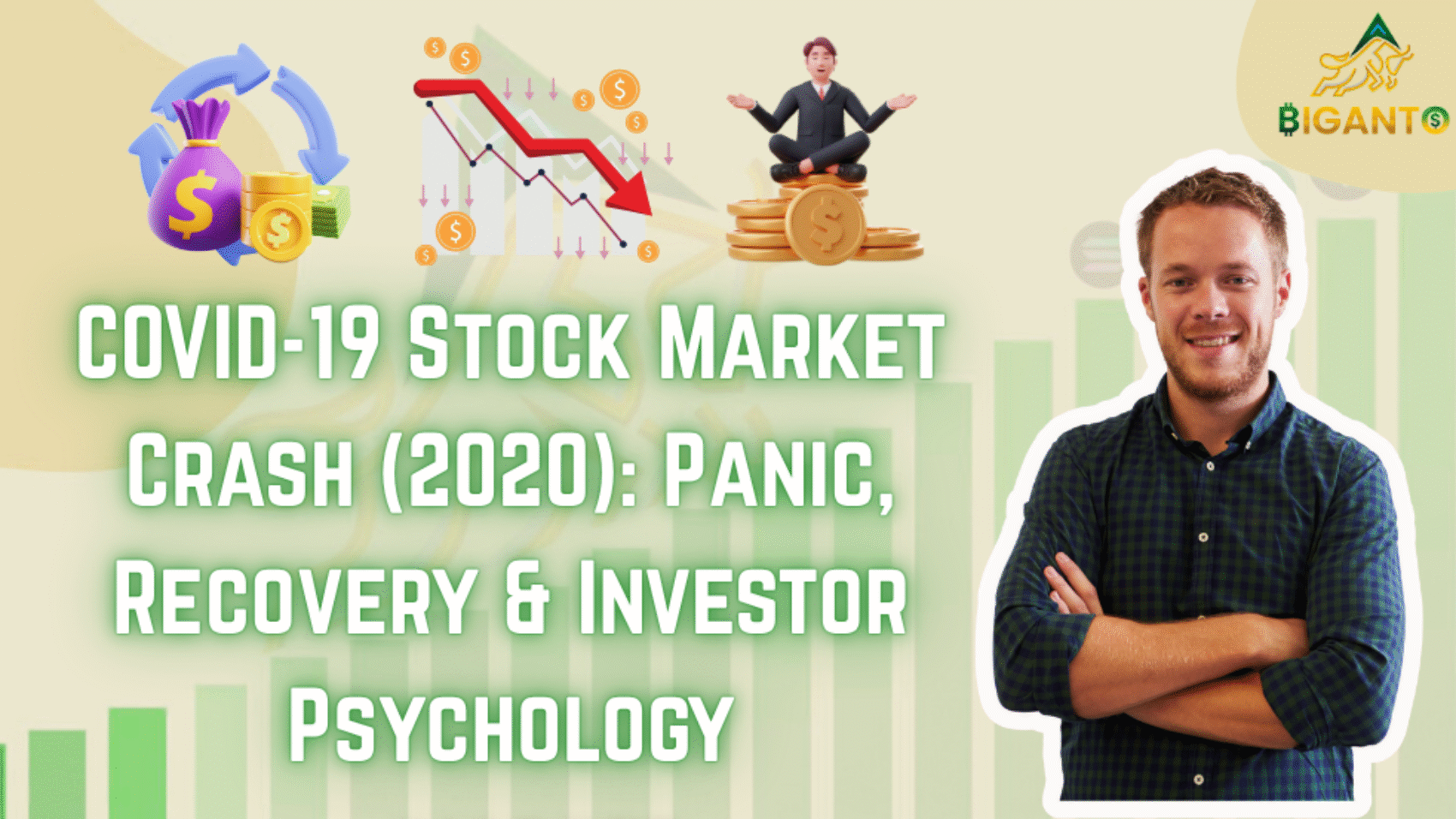Introduction
The COVID-19 pandemic, caused by the SARS-CoV-2 virus, was an unprecedented global health and economic crisis. According to the World Health Organization (WHO), the virus spreads through respiratory droplets during close contact—via coughing, sneezing, and even talking. What made it particularly dangerous was its ability to spread even before symptoms appeared, peaking in contagiousness during the early symptomatic phase.
Countries began rapidly enforcing restrictions: Italy imposed a national lockdown on March 10, followed by the UK’s first lockdown on March 23, fueling widespread global uncertainty and intensifying market volatility.
India also reacted with strict containment measures. On March 24, 2020, the Indian government imposed a nationwide lockdown, affecting over 1.3 billion people—the largest such lockdown in the world. The announcement sent shockwaves through the financial markets. Within just weeks, the BSE Sensex had fallen from over 42,000 in January to 25,981 on March 23, marking a 38% decline. The NSE Nifty 50 mirrored this fall, dropping below 7,600, erasing more than ₹30 lakh crore of investor wealth.
The COVID-19 pandemic proved more economically disruptive than prior global health crises. The evolution of the virus, combined with prolonged and widespread lockdowns, triggered supply chain breakdowns, labor shortages, and a sharp fall in consumer demand.
Understanding Market Crashes
To understand the dramatic crash and recovery of global stock markets in 2020, it is important to look at both financial theories and human psychology. Markets don’t always move on numbers alone—investor emotions, crowd behavior, and external policy actions often play a huge role.
Efficient Market Hypothesis (EMH) –
The Efficient Market Hypothesis (EMH) is a theory that says stock prices always reflect all the information available at that moment. In simple words, this means the market is “smart” and reacts quickly to any news—whether good or bad.
So, when news of the COVID-19 outbreak started spreading in early 2020, stock markets around the world crashed almost instantly. According to EMH, this sharp fall made sense—investors were reacting to the sudden shock and future risks.
But here’s the twist: markets also bounced back very quickly, even though the pandemic was still going on. This raised doubts—was the recovery based on real improvement, or were investors just reacting emotionally or being too optimistic? This shows that markets don’t always behave logically, and other factors like fear, hope, and psychology also play a big role.
COVID-19 and Market Volatility
The outbreak of COVID-19 in early 2020 sparked one of the most turbulent periods in modern financial history. As the virus spread across continents, bringing with it lockdowns, travel bans, and business closures, stock markets around the world reacted with extreme swings. Unlike previous financial crises driven by economic fundamentals, this was a public health crisis that created an unusual combination of medical uncertainty and financial panic. For the first time, market movements were influenced more by infection rates, press briefings, and policy announcements than by traditional economic indicators.
Market Crash and Record Losses
In the first quarter of 2020, global equity markets suffered dramatic losses within a short span of time. Between late February and March 2020, the Dow Jones Industrial Average fell by more than 35%, while the S&P 500 dropped by nearly 34%, marking its fastest-ever entry into bear market territory. India’s BSE Sensex, one of the oldest stock indices in Asia, plunged from 42,000 in January to just 25,981 on March 23, wiping out nearly 38% of its value. The Nifty 50 followed a similar path, crashing below 7,600.
The surge in fear was captured by the Volatility Index (VIX)—commonly known as the “fear gauge”—which spiked above 80, a level higher than during the 2008 global financial crisis. This extraordinary level of volatility indicated widespread panic and a complete lack of visibility into the future, as investors struggled to assess the impact of an unfamiliar and fast-moving threat.
Causes Behind the Extreme Volatility
The stock market volatility during the COVID-19 crisis was not driven by economic data alone. In fact, the speed and intensity of the crash revealed how investor sentiment, uncertainty, and psychological reactions became dominant forces in shaping market movements.
A major factor was health uncertainty. Investors had no clear understanding of how long the pandemic would last, how deadly the virus truly was, or how severely it would disrupt economic activity. This led to a climate of fear, where worst-case scenarios were priced in rapidly.
Another contributor was the series of policy surprises. Lockdowns, emergency declarations, and travel restrictions were announced overnight in many countries, leaving markets shocked and unprepared. Sudden government interventions—though aimed at saving lives—had unintended financial consequences, causing sharp swings in investor confidence.
A liquidity crunch added further stress. As fear intensified, both retail and institutional investors rushed to convert assets into cash, leading to forced selling and pressure across asset classes. Safe havens like gold and even government bonds saw unusual volatility as the demand for liquidity overshadowed normal investment logic.
Finally, behavioral factors amplified the situation. Emotional responses such as panic selling, herd behavior, and loss aversion—where investors feared further declines more than potential gains—drove mass exits from the markets. These psychological reactions triggered a self-reinforcing cycle, where falling prices led to more fear, prompting more selling.
COVID-19 and Investor Psychology
The COVID-19 pandemic fundamentally altered the global investment landscape, creating one of the most dramatic examples of how psychological forces can drive market behavior. Beyond the obvious economic disruptions, the pandemic triggered a cascade of psychological responses that transformed rational investors into emotionally-driven participants, leading to both the sharpest market crash since the Great Depression and one of the most remarkable recoveries in financial history.
Investors feel the pain of losses much more deeply than the pleasure of equivalent gains. As markets began to fall, even experienced investors panicked—not necessarily because of logical projections about company earnings or GDP declines, but because the emotional fear of losing money took over. The urgency to avoid further losses led to panic selling, often at irrationally low prices. In times of uncertainty, especially when individuals lack clear information or experience, Investors tend to follow the crowd.
During COVID-19, as one market after another began to fall, investors across the globe started selling—sometimes without assessing their own portfolio risks or opportunities. This “everyone is selling, so I should too” mindset led to a self-reinforcing cycle, where falling prices caused even more selling, accelerating the global market crash.
Social media and real-time news updates further intensified this herding effect. Panic headlines, case trackers, and market alerts constantly reinforced a sense of crisis, making it difficult for investors to think independently or stay calm.
Investors also showed signs of anchoring—the tendency to rely too heavily on the first piece of information they have. As prices fell far below those reference points, investors often perceived the situation as worse than it might have been. This cognitive bias made it hard for them to accept the new reality or judge recovery potential rationally.
The Recovery Phase:
After the rapid and historic global stock market crash between February and March 2020, what followed was an equally remarkable and surprisingly swift recovery. This rebound was not purely based on improving economic conditions, but rather driven by a combination of massive policy interventions, liquidity support, and a significant shift in investor sentiment. As panic began to settle, coordinated actions by governments and central banks around the world played a crucial role in stabilizing financial systems and restoring confidence among investors.
One of the biggest triggers for the rebound was the policy response. In the United States, the Federal Reserve reacted quickly by cutting interest rates to near zero and launching large-scale asset purchases (quantitative easing) to ensure liquidity in the markets.
Other major economies—including those in Europe and Asia—followed similar paths by rolling out unprecedented fiscal and monetary support to safeguard jobs, stimulate demand, and provide financial security.
The Reserve Bank of India (RBI) reduced the repo rate from 5.15% to 4.00%, announced moratoriums on loan repayments, and infused liquidity into the banking system through tools like LTRO (Long-Term Repo Operations). On the fiscal side, the Indian government launched the Aatmanirbhar Bharat Abhiyan, a ₹20 lakh crore economic stimulus package aimed at reviving small businesses, providing food security, and supporting the rural economy. Stock market story during this recovery phase was equally dramatic. After plummeting to a low of 25,981 on March 23, 2020, the BSE Sensex staged a robust comeback, climbing to 47,751 by the end of December 2020—an 85% gain in just nine months. Similarly, the Nifty 50 index rose from 7,610 to 13,981 during the same period.
This V-shaped recovery was fueled by strong performance in sectors like information technology, pharmaceuticals, FMCG, and telecom, all of which remained operational and in demand during the pandemic. Companies like Reliance Industries, which attracted massive global investments into its digital arm Jio Platforms, became leaders of the rally. IT giants like TCS, Infosys, and Wipro gained traction due to increased demand for digital services. Pharma stocks, such as Cipla, Sun Pharma, and Dr. Reddy’s, performed strongly on the back of rising healthcare demand and export opportunities. Confidence among Indian investors was further strengthened by the gradual reopening of the economy and early signs of recovery in GDP and industrial activity. The recovery of global and Indian stock markets after the COVID-19 crash was driven by a powerful mix of stimulus-driven liquidity, shifting investor psychology, and rapid policy responses.
Conclusion
The COVID-19 stock market crash was a unique event where investor psychology played as much of a role as economic disruption. Panic, uncertainty, and herd behavior led to a rapid global sell-off, including a 38% fall in India’s Sensex. However, aggressive policy responses and stimulus measures helped restore confidence, leading to a V-shaped recovery. This event highlighted how market movements are driven not just by data, but also by fear, perception, and emotional reactions—making psychology a crucial factor in financial markets.

